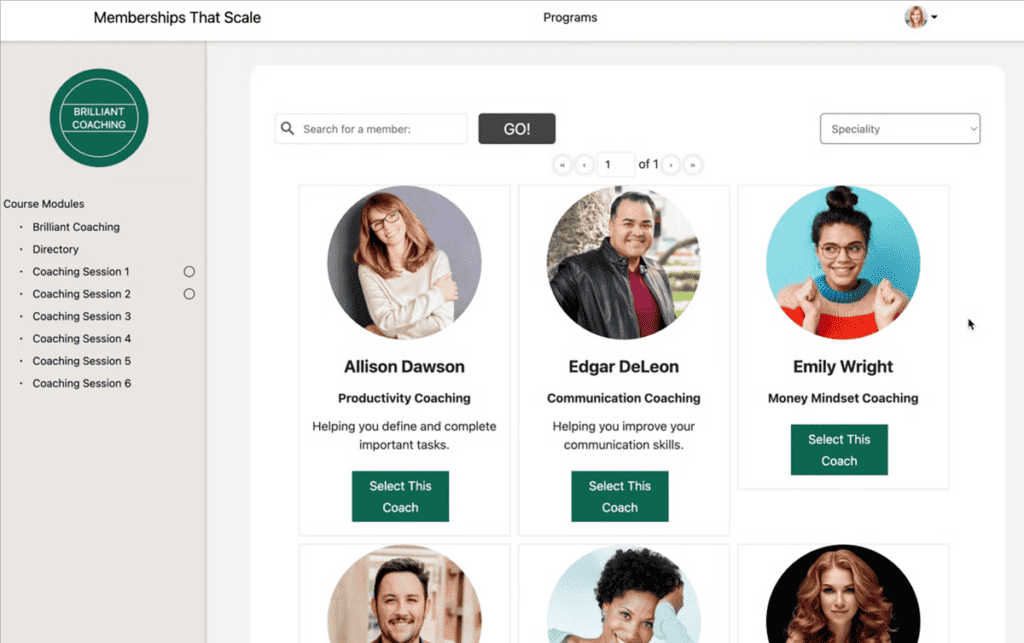There’s a key difference between scaling and growing a coaching business.
Growth happens when a company invests in more resources, and as a result, its revenue increases. Scaling, however, means increasing your revenue without investing in more resources or even working more hours.
Scaling a coaching business is hard because coaching usually involves the coach interacting with the students, and you can’t make exact copies of yourself to work with more clients without working more hours.
While being a successful coach who’s always fully booked is the dream for many, it can be tricky to scale from that point on. If you’re wondering how to scale your already successful coaching business, this article is for you.
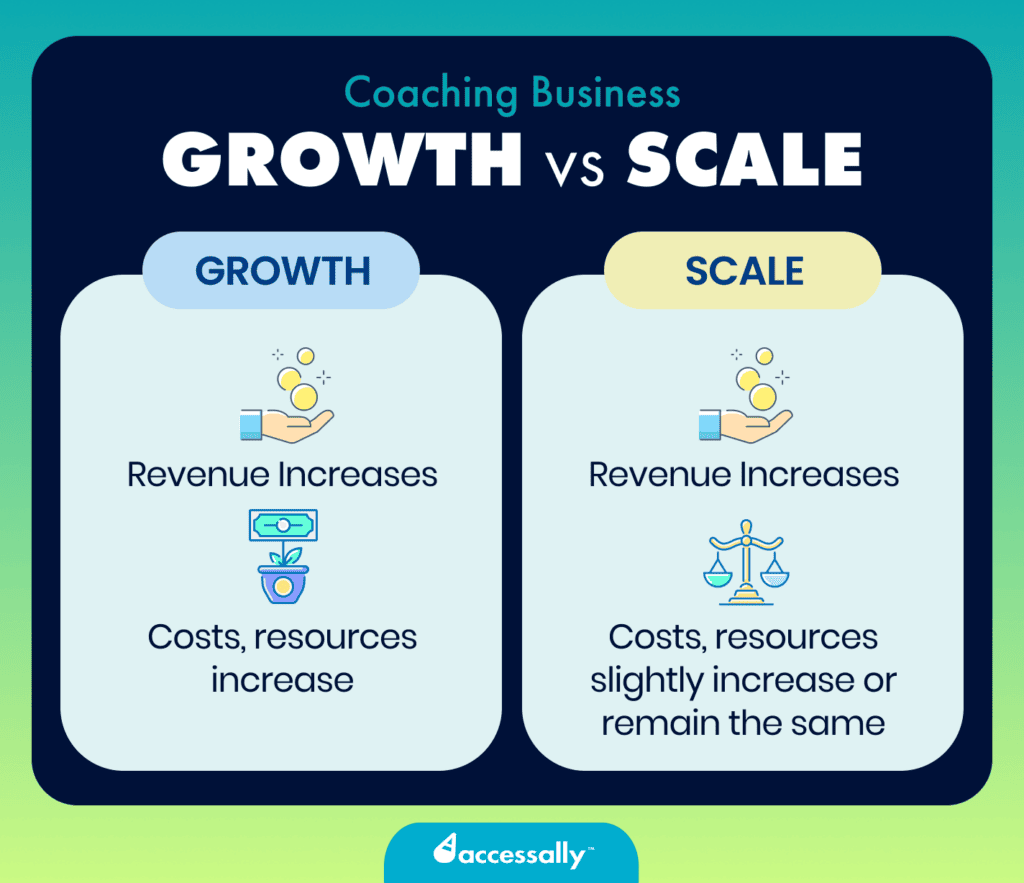
Coaching Businesses Are Difficult to Scale
By nature, a coaching business isn’t easy to scale. As a coach, you’re offering a personalized, 1:1 service, which means you can only serve one client at a time.
Plus, you can only serve a limited number of 1:1 clients per day. If you stretch yourself and put in more hours, you can take on more clients, but that’s not really sustainable for a longer period of time.
✅ Scaling a business is inherently about finding ways to make more money without putting in more work hours. And with a coaching business, this means either charging more for your 1:1 coaching offers or expanding your offers (or both).
There are 4 ways to scale a coaching business:
- Increase your prices,
- Hire other coaches to help,
- Switch to group coaching,
- Start selling online courses.
Let’s dive deeper into each one.


Charge More for 1:1 Coaching
Increasing your prices for 1:1 coaching is a smart strategy for scaling your coaching business without putting in more work hours. Simply raise your fees a little for every new client after successfully assisting the previous one.
Charging more won’t change how much time you spend with each client, and in most cases, it won’t change your acquisition costs, either. This means all this extra revenue will go straight into your bank account.
🎯 However, there’s still a limit on how much you can charge for your coaching offers. Sure, some coaches charge thousands of dollars for their 1:1 offers, but if your audience can’t afford such high prices, it’ll limit your ability to help more people.
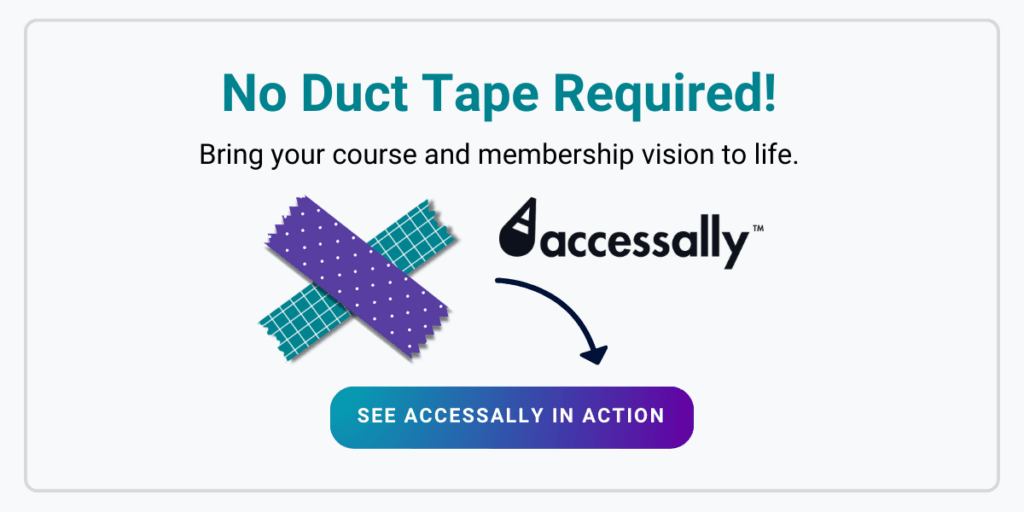

Hire and Train More Coaches
Another great way to scale your coaching business without changing your coaching model is to hire and train a team of coaches.
By hiring and training additional coaches, you can take on more clients and bank more money. Even though you continue to serve the same number of clients personally, having a team allows you to serve more clients collectively.
However, there are two downsides to this strategy.
First, not all the revenue from these new clients will directly come to you. Of course, you’ll need to compensate your team of coaches, meaning you’ll receive only a portion of the income.
Second, building a trustworthy team is challenging. The coaches you hire and train will represent your brand and coaching style. If they don’t meet the standards or deliver the same quality of coaching as you do, it can hurt your coaching brand in the long term.
Update Your Coaching Model
Another way to scale a coaching business is to serve more than one client at a time. How? By diversifying your coaching model and expanding your offers.
In addition to your 1:1 coaching, introduce group coaching, either independently or in a hybrid format (group + 1:1 coaching). Another option is to create a membership-based program.
🎨 The beauty of this approach is that you can introduce diverse coaching options while also raising prices for your 1:1 sessions. This can help you scale your business even more and significantly increase your revenue.
Start Group Coaching
Switching or expanding from individual coaching to group coaching is the next step for many coaches looking to scale their businesses. This is a great way to serve more than one client at a time and grow your revenue without overworking yourself.
However, before you dive head-first into creating a group coaching program, there are a couple of things to consider.
Group coaching is more structured than 1:1 coaching.
When serving your clients in a 1:1 setting, you can allow the sessions to run their course and follow the client’s needs. But, in a group setting, clients will expect a structured program to follow. You’ll have to prepare the program’s curriculum in advance, including any resources and materials needed to run each session.
Group coaching is less personalized than 1:1 coaching.
Sure, group coaching is about getting together people who share the same goal or struggle and helping them achieve the desired results. However, a group coaching program isn’t right for everyone. Clients who want your undivided attention and need a very personalized approach will still prefer to work with you 1:1.
Group coaching isn’t ever-green as opposed to 1:1 coaching.
When you offer 1:1 coaching, you’d usually take on clients all year round (as long as you have availability). But since group coaching requires more effort to put together, it’s typically offered a few times per week for a specific amount of time, for example, twice a year for 6 weeks.
Try a Hybrid Model
Instead of settling for just one coaching model, why not combine them? That’s exactly what the hybrid model is: a combination of two different ways of coaching, which allows you to serve more clients alongside your existing 1:1 coaching clients.
There are two types of hybrid coaching:
Synchronous + asynchronous coaching
While you might think that coaching is inherently synchronous (meaning communication happens in real-time), you’re probably coaching your clients asynchronously all the time.
Asynchronous coaching is when there’s a lapse between the client’s question and the coach’s response.
Take Voxer, for example. Many coaches use it as a support to their 1:1 coaching. If a client has a question between the sessions, they can message the coach via Voxer anytime, and the coach will respond when they can.
You can offer asynchronous coaching as an add-on to your 1:1 offers for those clients who need additional support and can afford a higher price.
Group + 1:1 coaching
By combining a group program with 1:1 coaching, you can offer your coachees an opportunity to work with you 1:1 alongside the group program. In this model, the group program is the core offer, and 1:1 calls are typically used to provide additional support to those who need it.
You can offer your clients an option to choose between the group program only (at a lower price point) and the group program with extra 1:1 support (at a higher price point), which is a great way to increase your revenue from the group program.
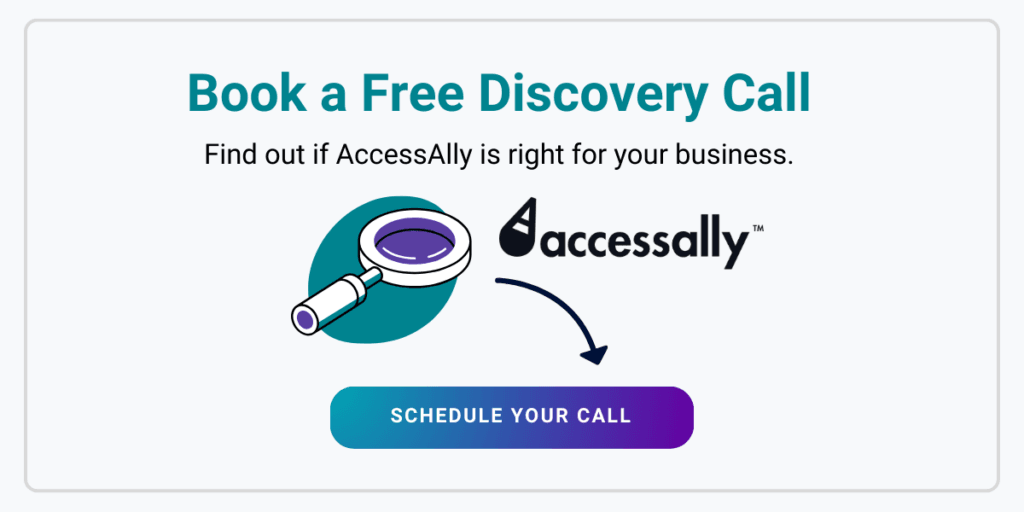

Create a Membership-Based Program
With a coaching membership, your clients can sign up for a subscription-based coaching service instead of hiring you 1:1 just once. This way, they receive continuous coaching support while you get steady recurring revenue each month.
Membership-based programs can entail anything you’d like to offer your clients on a month-to-month basis, such as:
- Monthly group coaching sessions,
- Weekly Q&A sessions,
- 1:1 support via videoconferencing,
- Asynchronous 1:1 support via Voxer,
- Access to the community Facebook group,
- Access to video lessons and digital resources.
Create an Online Course
The best way to scale a coaching business is to create and sell an online course. With a course, you can package all your knowledge into a learning program that can be sold over and over again.
Unlike other scaling strategies, there’s no cap on how much money you can make with online courses. The more students sign up for the course, the higher the revenue – and there’s no limit to how many students you can enroll.
You’re not sure which platform you should choose to create your online course? The decision chart below is here to help you:
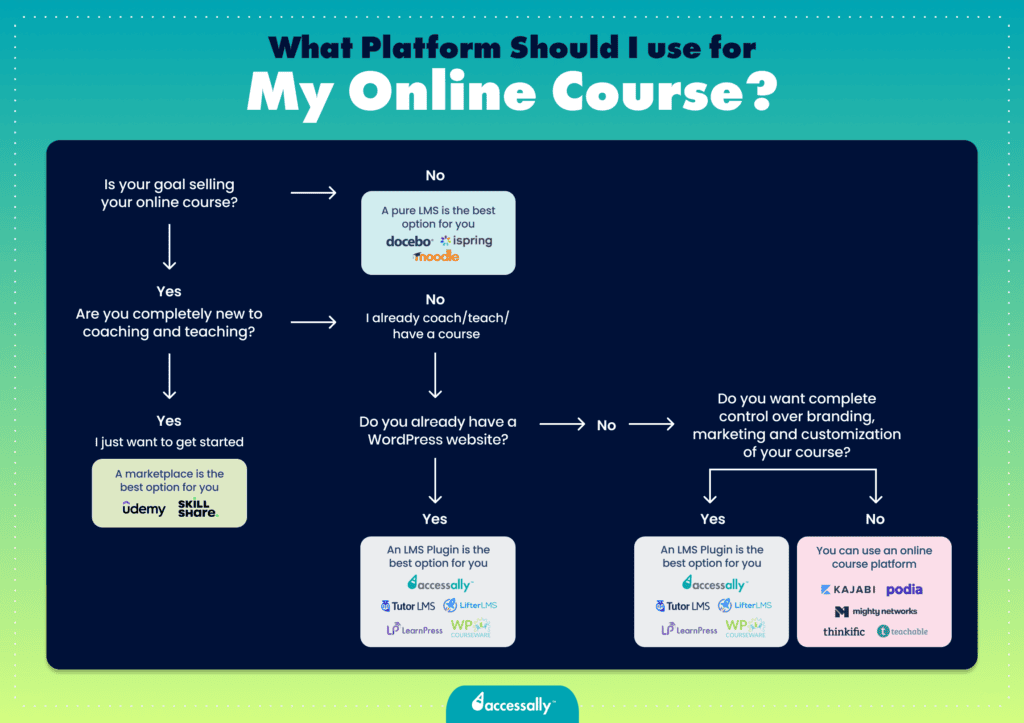

If you’re an established coach looking to scale your business with online courses, your best bet is to self-host your course on your WordPress website using an LMS plugin like AccessAlly.
While you’ve surely considered using platforms like Kajabi or Podia, we don’t recommend doing that unless you’re okay with limited customization, branding, and scalability. But if you’re a successful coach with an audience full of potential clients who will jump at the opportunity to buy your course, go for an LMS plugin.
An LMS plugin allows you to customize your online course platform to match your brand and give you more flexibility and control over your students’ learning experience, which can be a game-changer for your brand.
If you’re wondering which LMS plugin to choose, take a look at the table below:
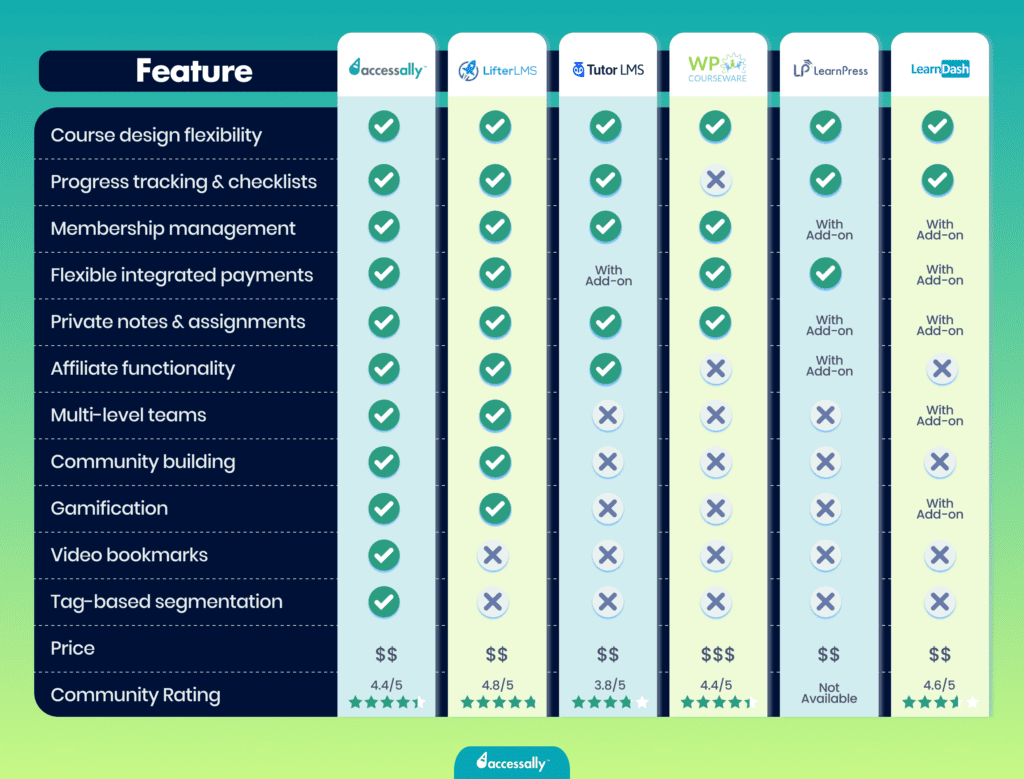

Here are some examples of coaches who scaled their business with AccessAlly, in case you’re looking for inspiration:
- Marc Wayshak uses AccessAlly to sell group programs to big corporate clients.
- The Congruent Mystic uses AccessAlly to streamline his coaching program and students’ learning experience.
- Natalie MacNeil, the founder of Coaching Evolved, uses AccessAlly to host a monthly membership program on her website.

